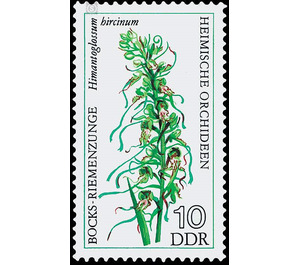Native orchids - Germany / German Democratic Republic 1976 - 10 Pfennig
Theme: Flora
| Country | Germany / German Democratic Republic |
| Issue Date | 1976 |
| Face Value | 10.00 |
| Color | green |
| Perforation | K 12 1/2: 13 |
| Printing Type | offset |
| Stamp Type | Postage stamp |
| Item Type | Stamp |
| Chronological Issue Number | 1877 |
| Chronological Chapter | GER-DDR |
| SID | 780618 |
| In 25 Wishlists | |
Native Orchids The Ministry of Posts and Telecommunications of the German Democratic Republic publishes six multi-colored special postal stamps depicting native orchids. NATURE RESPONSIBILITY - ORCHIDS With more than 20,000 species, orchids are one of the richest and most diverse plant families in the world. Since time immemorial, they claim the special interest of countless nature lovers because of their beauty and colourfulness. Their main area of distribution are the tropics and subtropics, where they mainly occur as tree-breakers (epiphytes). In temperate climates, including Europe, they are already reaching the limit of their distribution and are exclusively soil dwellers. Their share of the total number of European plant species reaches just under 2 percent. Here they are mainly bound to locations that were created by limited human intervention and management forms. This results in the particular problem of their conservation in Europe in connection with the worldwide efforts to protect them, in which the GDR, in which as one of the few countries without exception all orchids are protected, occupies a leading position in the world. 10 Pfennig value: Bocks belt tongue - Himantoglossum hircinum (L.) COOK The main distribution area of this heat and lime-loving species is in the Mediterranean and the warm areas of Western Europe - to the south of England. In Central Europe, the 30-to-100-cm-high autumn-leaved species, with its peculiarly shaped flowers emanating an unpleasant stink odor, presents itself as a great rarity in the extensively managed, meager semi-arid lawn and shrubbery. Their northernmost Central European deposits, which are already located outside the closed distribution border, are located in the mussel limestone areas of the south of the GDR (Thuringia).


